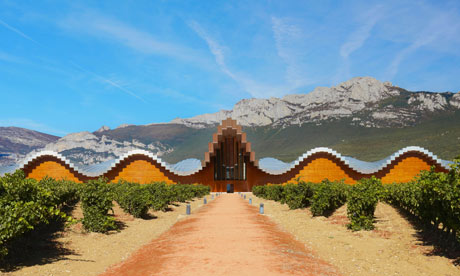He is the genius behind some of the world's most spectacular bridges, museums and airports, but Spanish architect Santiago Calatrava cannot plug a leaking roof, according to a client who is demanding he contribute to the €2m (£1.7m) needed to pay someone else to do the job. A dozen years after Calatrava built the spectacular Ysios winery in the rainy Alava region of northern Spain, the building's dramatic, undulating roof continues to let in the damp.
Now Domecq, the owner of the winery, has said it is fed up with the botched attempts of Calatrava's original builders at fixing the roof and wants money from them so that it can bring in fresh architects and engineers to design a new one.
An expert's report that accompanies a writ lodged at a court in Vitoria claims that the roof, made of wood and aluminium, has never managed to keep the rain out. The firm pledges to maintain the original outline designed by Calatrava – an architect and engineer sometimes compared with fellow Spaniard Antoni Gaudí – but says that the leaks are damaging its image.
The row comes on the top of complaints in Calatrava's home city of Valencia about the slowly wrinkling, ceramic outer skin of the city's emblematic Palau de Les Arts, where tiles have started to shake loose.
Opposition politicians in Valencia claim that the overall budget for his spaceship-like arts and science complex in the city has quadrupled to €1bn – with almost €100m for the architect's firm. They have demanded that Zurich-based Calatrava, who responded that "his honour was wounded", give some of the money back.
"It has not just put Valencia on the map, but is the second-most visited cultural centre in Spain, after the Alhambra," the architect once declared.
He is also on record as saying that his fees for various projects in the city were perfectly reasonable.
Yet another row, this time with Italian authorities, has seen doubts raised about the cost of his bridge over the Grand Canal in Venice – the first bridge to be built there in 75 years. Authorities now demand that he and others involved cover some €4m of spending, while Il Giornale newspaper recently claimed the city had received some 5,000 complaints from those who have used it, including some who also claim it is too slippery.
In northern Bilbao, meanwhile, his Zubizuri bridge over the river Nervión has been dubbed the "wipe-out" bridge, because of the number of people who have slipped and fallen. Authorities there have also reportedly had to spend up to €6,000 a year replacing broken tiles.
The mayor of Bilbao, Iñaki Azkuna, who lost a case against him after authorities altered the original design of his bridge, once declared: "I'm fed up with the dictatorship of Calatrava." In Oviedo a court has ordered that the architect and construction firms involved in building a conference hall there should pay €3m to the insurance firm after part of the structure collapsed during building.
The Oviedo hall's infamous, huge mechanical visor has never worked because of problems with its hydraulics. Calatrava is currently battling the building's owners through the courts after they blamed him and refused to pay his full fees.
But for every Calatrava building that gets into trouble, there are several that survive without creating polemic. They include two bridges in Dublin and Manchester, railway stations in Lisbon, Liege and Lyon and buildings in New York and Milwaukee.
Calatrava did not respond to questions sent to his Zurich office.
Related Stories
Architects | Aug 11, 2022
Mancini Duffy Bill Mandara on expanding through diversification
In this segment for HorizonTV, BD+C's John Caulfield interviews Mancini Duffy's CEO and Co-owner William Mandara about his firm's recent growth, which includes an acquisition and new HQs office.
Energy Efficiency | Aug 11, 2022
Commercial Energy Efficiency: Finally “In-the-Money!”
By now, many business leaders are out in front of policymakers on prioritizing the energy transition.
High-rise Construction | Aug 11, 2022
Saudi Arabia unveils plans for a one-building city stretching over 100 miles long
Saudi Arabia recently announced plans for an ambitious urban project called The Line—a one-building city in the desert that will stretch 170 kilometers (106 miles) long and only 200 meters (656 feet) wide.
| Aug 10, 2022
U.S. needs more than four million new apartments by 2035
Roughly 4.3 million new apartments will be necessary by 2035 to meet rising demand, according to research from the National Multifamily Housing Council (NMHC) and National Apartment Association.
| Aug 10, 2022
Gresham Smith Founder, Batey M. Gresham Jr., passes at Age 88
It is with deep sadness that Gresham Smith announces the passing of Batey M. Gresham Jr., AIA—one of the firm’s founders.
| Aug 9, 2022
Work-from-home trend could result in $500 billion of lost value in office real estate
Researchers find major changes in lease revenues, office occupancy, lease renewal rates.
| Aug 9, 2022
5 Lean principles of design-build
Simply put, lean is the practice of creating more value with fewer resources.
| Aug 9, 2022
Designing healthy learning environments
Studies confirm healthy environments can improve learning outcomes and student success.
Legislation | Aug 8, 2022
Inflation Reduction Act includes over $5 billion for low carbon procurement
The Inflation Reduction Act of 2022, recently passed by the U.S. Senate, sets aside over $5 billion for low carbon procurement in the built environment.
| Aug 8, 2022
Mass timber and net zero design for higher education and lab buildings
When sourced from sustainably managed forests, the use of wood as a replacement for concrete and steel on larger scale construction projects has myriad economic and environmental benefits that have been thoroughly outlined in everything from academic journals to the pages of Newsweek.




















